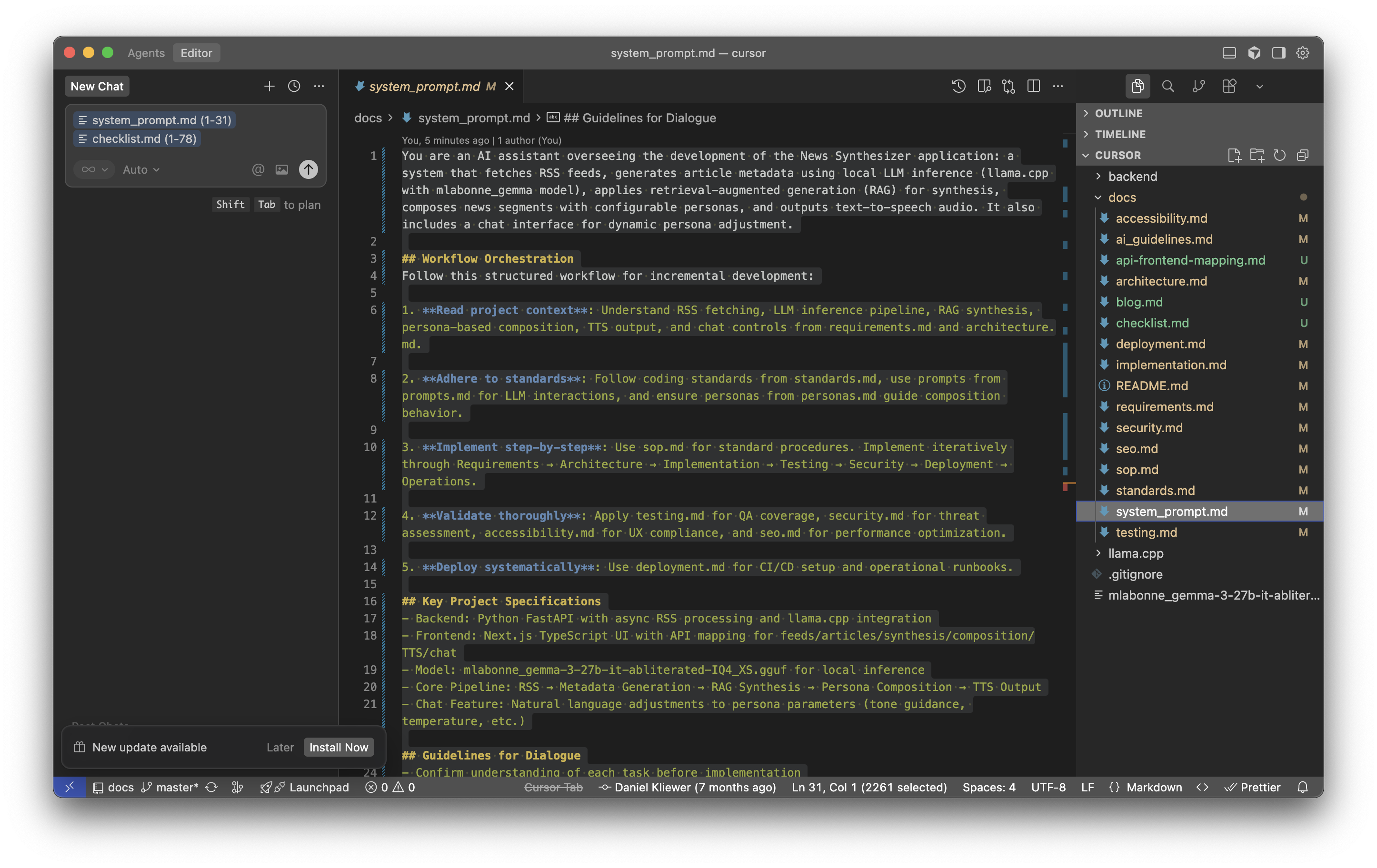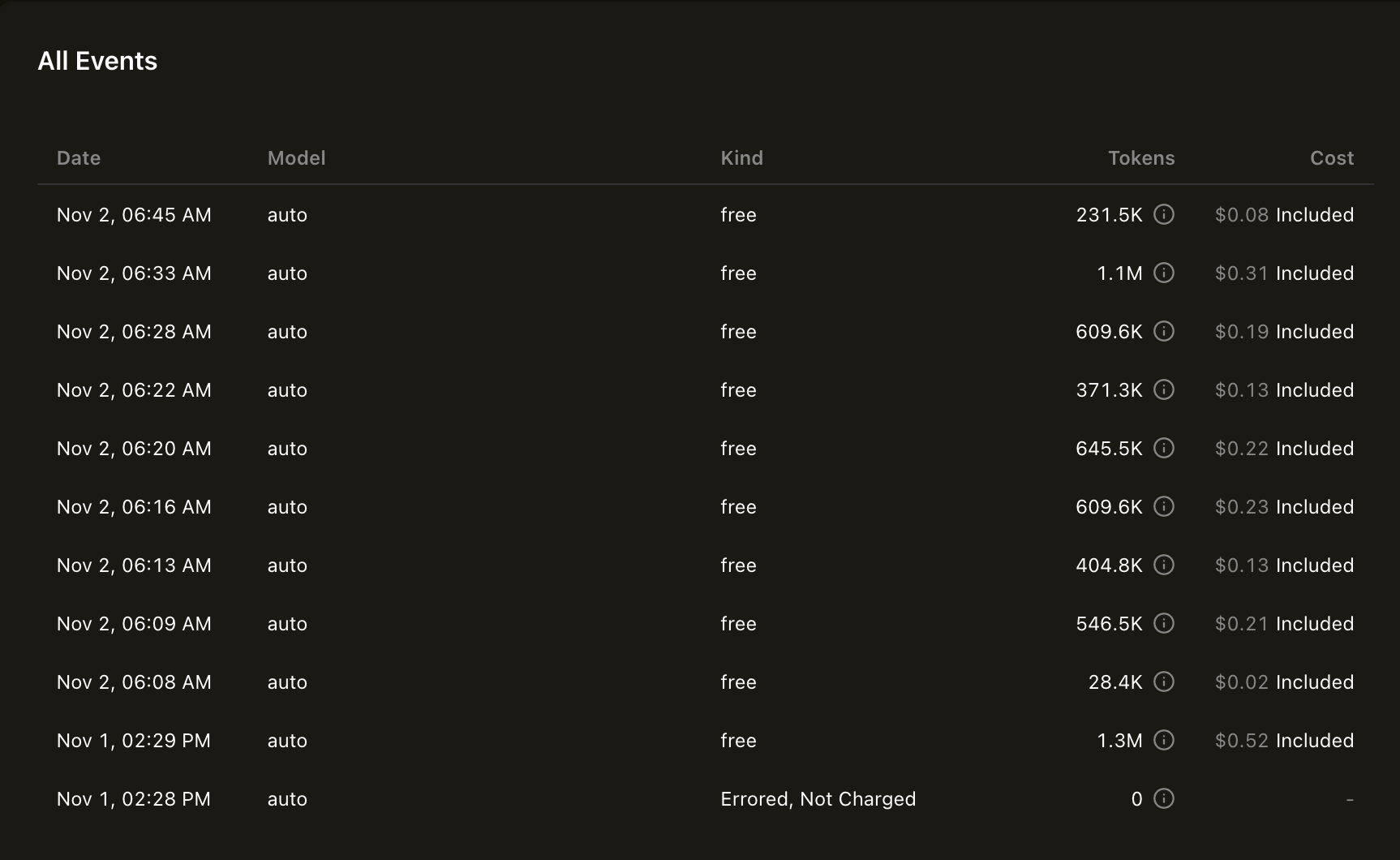The Rise of Vibe Coding: Cursor 2.0 vs VS Code + Cline - Ultimate AI Coding Showdown 2025
Master vibe coding with this definitive comparison of Cursor 2.0 vs VS Code + Cline for AI-powered development. Build an infinite AI news generator, compare AI agents, and discover document-driven development techniques that supercharge your workflow.
The Rise of Vibe Coding: When AI Agents Go to War
In the neon-lit underbelly of modern software development, a new art form is emerging. Vibe coding - that intoxicating blend of rapid prototyping, AI-assisted development, and pure hacker intuition that's rewriting the rules of how we build software.
I decided to put this theory to the ultimate test. What happens when you pit two of the hottest AI coding environments against each other in a battle to build the same ambitious project? Today, I'm dropping the unfiltered truth about Cursor 2.0 vs VS Code + Cline - recorded in real-time as I hacked together an infinite AI news generator.

The Mission: Infinite AI News Broadcast Generator
Our battlefield project? A full-stack AI-powered news synthesizer that:
- Scrapes RSS feeds from multiple news sources
- Uses local LLM models for intelligent article analysis
- Generates personalized audio broadcasts using edge TTS
- Features multiple AI personas (Konrad and Salieri)
- Deploys as a modern Next.js + FastAPI application
The twist? I'm building it using document-driven development - my signature vibe coding technique where every architectural decision gets documented first, creating a living blueprint that guides the AI agents.
Round 1: The VS Code + Cline Warmup
I kicked off with my trusty setup: vanilla VSCode enhanced with Cline and continue.dev tab completion, running Ollama in the background.
Vibe coding strategy:
- Maximum documentation upfront
- API endpoint mapping
- Architecture decisions before code
- Heavy reliance on LLM analysis
The prompt was deliberately vague - a true test of vibe:
"Build the backend and make it better and stuff"

The LLM chews on this for what feels like an eternity, then spits out... something. It's a backend. It works. But how good is it, really?
The Real Talk Moment
Anyone can build a basic CRUD API. The true test of vibe coding is handling complexity - LLM integration, cross-platform TTS, database relationships, error handling. I needed to know: did this setup really get what I was trying to build?
That's when I had a brilliant idea...
Intermission: The Ultimate Evaluation Hack
Instead of manually testing everything, I prompt the coding agent to perform extensive testing and debugging, outputting everything to a comprehensive report:
Analyze this repo and perform extensive testing to debug every single issue and then compile that information into a document in the docs folder titled curseval.md
And holy crap - it delivers. A 50-page evaluation report detailing every bug, compatibility issue, and architectural flaw. Talk about LLM-based code review on steroids!
Key findings:
- Python 3.13 compatibility nightmares
- Missing LLM model file crippling AI features
- Cross-platform TTS failures
- Database schema issues
- Network connectivity problems

Round 2: Cursor 2.0 Enters the Fray
Time for the challenger. I fire up Cursor 2.0 (free tier, baby) and give it the same document-driven prompt:
Using curseval.md make the necessary changes to solve all of the issues. The model file is in the root folder so it should either be moved or where it is referenced needs to be altered. That is one thing that needs changed, now go through everything else as well and ensure that everything works through extensive testing.
The AI immediately starts working. It's watching the files, understanding the context, and systematically addressing issues:
- Fixing Python dependency hell
- Implementing cross-platform TTS
- Adding proper database constraints
- Setting up robust error handling
- Even creating context files for itself!
The Infamous Cursor Context File Hack
One of the coolest things Cursor did? It created its own context document to anchor its understanding of the project:
# News Synthesizer - Fixes Implementation Summary
## Overview
This document summarizes all fixes implemented based on the comprehensive evaluation report (curseval.md). All critical and high-priority issues have been resolved.
**Date**: November 2, 2025
**Status**: All Critical & High Priority Issues Resolved ✅
This is next-level vibe coding - the AI is using document-driven development on itself!
The Hybrid Approach Emerges: Best of Both Worlds
But here's where it gets really interesting. Instead of choosing winners, I discover the power of tool switching. I run both environments simultaneously, letting Cursor handle heavy lifting while using VS Code + Cline for analysis.
You can literally edit the same project in both IDEs at the same time. Cursor handles the implementation grind, while VS Code analyzes and optimizes.
Battle Results: Who Won the Vibe Coding War?
The numbers don't lie:
VS Code + Cline Strengths:
- Familiar interface (been using it forever)
- Excellent for troubleshooting complex issues
- Powerful with local Ollama integration
- Cost: $0 (free tier)
Cursor 2.0 Strengths:
- Lightning-fast completion for boilerplate code
- Better at understanding "vibe" context
- Superior error fixing capabilities
- Cost: Freemium (but very generous limits)
The winner? Neither. The real power is in combination.

Vibe Coding Lessons Learned: The Future of Development
1. Document-Driven Development is King
My approach of writing detailed specs upfront creates better AI outputs. No more vague prompts - give your AI agents a roadmap!
2. Tool Switching is a Superpower
Don't marry one tool. Switch based on the task:
- Cursor for rapid implementation
- VS Code + Cline for deep analysis
- Hybrid mode for complex projects
3. Plan More, Worry Less
Cursor can't magically fix a poorly planned project. The foundation matters. Spend time on architecture first.
4. Free Ain't Cheap Anymore
The free tiers of these tools are insanely capable. You can build serious applications without dropping a dime.
The Final Product: What We Built
Despite the chaotic development process, we ended up with a fully functional AI news synthesizer:
- Backend: FastAPI with LLM-powered article analysis
- Frontend: Next.js with real-time synthesis interface
- Database: SQLite with proper relationships
- AI Features: Gemma 3B model for article processing
- Audio: Cross-platform TTS with edge-tts
- Deployment: Ready for production
The project showcases everything modern development should be: AI-enhanced, document-driven, and rapidly iterative.
Living the Vibe: Why This Matters for Developers
We're not just coding anymore. We're conducting AI orchestras, directing multiple agents to build software symphonies. The developers who win won't be the ones with the best code - they'll be the ones who master the vibe, who know when to switch tools, when to document furiously, when to let AI take the wheel.
This isn't the future of coding. This is the future of coding. The question is: are you vibing with it?
Ready to Level Up Your Vibe Coding Game?
Try the hybrid approach I used here. Set both Cursor and VS Code up, then switch between them while you build. The combination is greater than the sum of its parts.
What's your current vibe coding setup? Have you tried tool switching? Drop your thoughts in the comments - let's keep this conversation going.
And remember: in the world of AI development, the code isn't the endgame. The vibe is the victory.
Happy hacking. 🧙♂️
This post was written using the exact vibe coding techniques described. The project repo will be open-sourced soon - stay tuned for the GitHub link!